The ‘parachutist’s badge’ – more commonly referred to as jump wings – was the mark of a paratrooper, and it still is today. Over the years, I acquired a number of them, but really collecting jump wings can be an expensive hobby in it’s own right. So this article is meant to be a virtual reference, drawing on several collections to give you the completest possible overview of the many different variations and makes that exist. If you have wings you don’t see here, send me a picture and I will add it.
History
Much has been written about the history of the badge. What follows is a text I have found on many sites, so I have no idea who originally wrote it. If anyone can tell me who did, I will gladly quote the author. Through further research, I found some other interesting facts to add. My additions are marked in italics:
The first Parachute badge was designed during World War II by Captain (later Lieutenant General) William P. Yarborough of the 501st Parachute Battalion. A memorandum of record written by Captain Yarborough on April 22, 1941, tells the story of the birth of the parachute badge “On March 3, 1941, I was ordered to Washington to report to the Adjutant General for temporary duty in the Office of the Chief of Infantry. My mission was the procurement of a suitable parachutist badge which would meet with the approval both of the War Department and the Commanding Officer of the 501st Parachute Battalion. Major Miley (commander of the 501st), before my departure, gave me full authority to approve any design that I considered acceptable, and to do so in his name. The same authority was delegated to me in the name of the Chief of Infantry. “I drew the original sketch in the office of Lieutenant Colonel Beuchner, G-3; a finished copy of my original sketch was prepared in the office of the Quartermaster General (he came up with the eventual design after dozens of sketches). Through the help of Mr. A.E. Dubois, in the Quartermaster General’s office, 350 of the badges were procured from the Bailey, Banks & Biddle Company in Philadelphia and were in the hands of the Commanding Officer of the 501st Parachute Battalion by March 14, 1941. This is believed to have been an all time speed record for War Department Procurement.” “I personally took the correspondence relative to the badge’s approval from one office to another until the transaction was complete. This operation took me one entire week, eight hours a day.”
Captain Yarborough even applied for a patent to protect the design from unauthorized reproduction. On February 2, 1943, Patent #D134963 was granted for “A Parachutist’s Badge” for a period of three and one-half years. I surfed to the US Patent Office and looked it up. Sure enough, it’s all there online. Click on the pictures below to enlarge.
The Parachutist’s Badge was formally approved on 10 March 1941. The senior and master parachutist’s badges were authorized by Headquarters, Department of the Army in 1949 and were announced by Change 4, Army Regulation 600-70, dated 24 January 1950. For more information on these post-war wings, check the list of related links at the bottom of this page.
Later, as a retired Lieutenant General, Yarborough would recall how it all came about in a letter to “Static Line” – a monthly publication by Don Lasson, thus ending all speculation on the subject. So here it is from the horse’s mouth:
The wings could be worn by soldiers who has passed the parachutist’s training or who had made a combat jump without prior training.
Different types of wings
Size-wise, all types of wartime wings are pretty much identical (1 13/64 inches in height and 1 1/2 inches in width is the official size), and all are silver. The main differences are found in the attachments and the country of manufacture. When you have collected those main varieties, and you still have money to burn, you can start collecting the different manufacturers and wings with devices attached (stars, arrowhead, cross, …). I grouped all the pictures in categories. These are not official categories, because officially, there was only one approved design.
Attachments
There are 3 main types of fastening devices: the US-made pinback with rolling lock; the British made pinback; and finally the clutch back. I’m not sure if screw back wings existed, but I haven’t seen any yet.
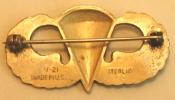 |
 |
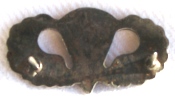 |
| Pinback | British made | Clutch back |
The US-made pinback as per Yarborough’s original specifications is the most intricate type. “Pin stem, hinge and catck to be made of nickel silver, silver plated. Pin stem to be 1.45” long. Hinge to be flat joint type. Catch to be the ball shaped safety type. Hinge and catch to be soldered to badge with silver solder”. The Britsh-made pinback is a more basic hook and clasp affair. The needle is much thicker than on American wings, as is common on other British insignia. Clutch backs were introduced late in the war and are still used today. As a result, it is very difficult for the untrained eye to identify a clutchback as WWII issue. Actually, at the time, clutch back fasteners cost more and they were prefered by many because it was much easier to put them on straight! WWII wings should be silver, but they don’t have to be marked ‘sterling’. It is possible that they also don’t bear a manufacturer’s hallmark. WWII badges were often polished smooth to better stand out on the uniform. If you want to buy WWII clutchback wings, you want to look for that authentic old patina, or be certain of their provenance. Which is why many collectors reject them out of hand. Incidentally, my very first wings were clutchbacks (which was more thanks to luck than wisdom).
The latest addition to my collection are these pinbacks I was able to buy these clutchback wings from the estate of the late Colonel Archie Hyle. He was a paratrooper in WWII and went on to command the 1st Aviation Brigade in Vietnam. These are full size, and sterling marked and have been polished down so most details have faded away – an attempt to exemplify the wearer is an old salt!
Countries of manufacture
Other than by their fastening devices, US- and British made badges can be recognized by the different design of the front side. The British design is more ‘outlined’. I have no idea why they didn’t just copy a US made wing. Maybe they thought it would be more fun for collectors.
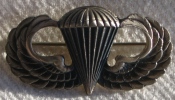 |
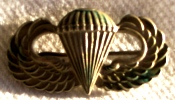 |
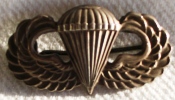 |
| One American (left) and two British-made badges by Gaunt and Ludlow. Note the outlined design. | ||
Stars and arrowheads
Combat stars and invasion arrowheads were not official, but were accepted and worn with great pride. This does not mean that it was such common practice that everyone who qualified also had their badges modified. Many badges were probably only modified just after the war, the same way that special insignia weren’t sewn onto uniforms until after the war. Each star equals a combat jump and an arrowhead stands for a jump on June 6, 1944. The maximum number of stars allowed was 5, and it still is. Yarborough himself earned 4 stars on his wings. The same practice applies to glider wings, but I’m keeping that for another article.
These wings belonged to Earl Kenneth Rosebury, 11th ABN, 511th PIR. The combat star must be for a jump into the Philippines or mainland Japan. Massive pin, no visible hallmarks.
These wings belonged to Gordan W. Yates, 101st ABN, 506 PIR, 3rd Bn, Co H – winner silver star, bronze star 3 times, purple heart 3 times. The bronze arrowhead is for participation in the Normandy invasion. The bronze stars are for combat jumps in Normandy and Holland. Hollow pin.
These wings belonged to William “Willie” Ubinger, 82nd ABN (HQ), 504th PIR. The bronze arrowhead is for participation in the Normandy invasion. The bronze stars are for combat jumps in Sicily, Normandy, Holland and the Rhine.
Other devices
A special hobby can be made of collecting wings decorated with other unofficial devices, such as a chaplain’s cross, a rabbi’s star of David, a Cross of Lorraine, a rigger ‘R’, a unit number, etc. Click on the pictures belowed for a detailed view.
Don’t take the pictures above as gospel. For example, different chaplain’s wings may look different, just as chaplain’s crosses varied in style and size. Such wings are merely combinations of existing insignia.
Combined parachute and glider wings
This is also an unofficial insignia. It seems that this practice came out of the 11th Airborne Division. I don’t know more about it. They are quite rare today. Beware of replicas.
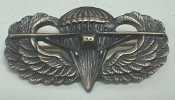 US made – Collection Henri van Meel |
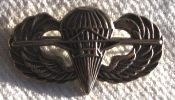 British made |
Makers
The makers of the first 350: Bailey, Banks & Biddle Company in Philadelphia All of these first wings bear BB&B on the back and they are a rare collector’s item. Other makers I know of:
I came across this list on a site called World War II Paratroopers where the author lists all known makers of US jump wings and glider qualification badges. The list includes a lot of manufacturers of which I do not yet have any photos in my article, so I would be grateful for any missing photos that people could send me!
I reworked this list into this table:
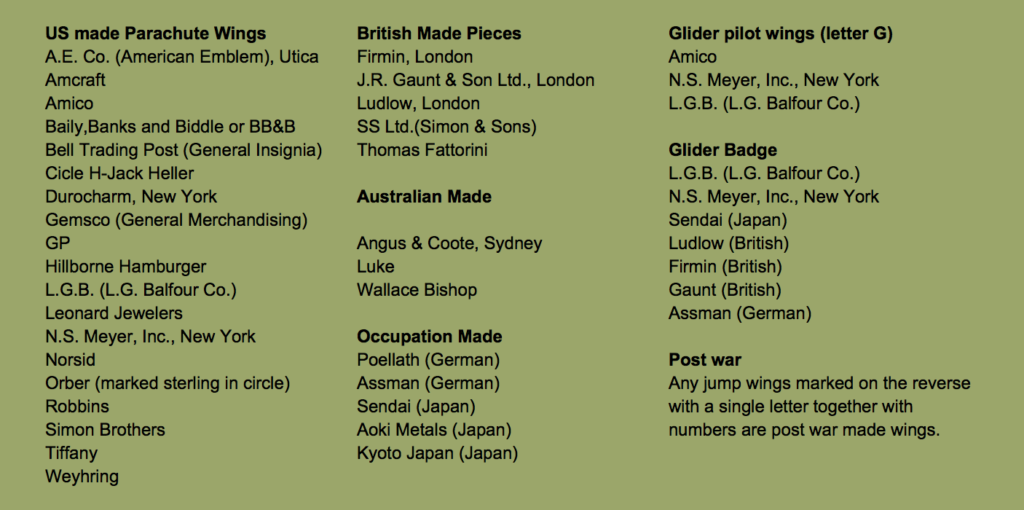
Packaging
Most wings were probably sold without any packaging, and today very few examples remain complete in their original box, wrap or presentation card.
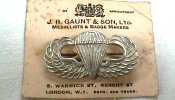 J.R. Gaunt presentation card Collection Henri Van Meel |
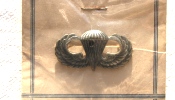 Wing on card in wrap only marked ‘Sterling’ |
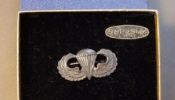 Gemsco wing in box |
Parachutist’s patch
Wikipedia tells us that the parachutist’s badge replaced the parachutist cap patch. In all my research I haven’t managed to find another source to confirm this. If anything, this word ‘replaced’ is inaccurate, because the cap patch did not disappear when the badge was introduced. However, the cap patch with the parachute design was gradually replaced by a combined para/glider cap patch later in the war.
Ovals
Cloth ovals were introduced shortly after the introduction of the first wings. Quoting Gen. Yarborough from his letter to “Static Line”: “Feeling that the wings needed a little color and that perhaps they were on the small side, I designed the first felt backgrounds. For the 501st the background was Infantry Blue with Artillery Red superimposed so as to leave a narrow blue border”. Such felt backgrounds are now very hard to find (and hard to identify as originals). More common, but still rare, are the ovals made of cotton twill with a cheescloth backing and a narrow contrasting embroidered border. The center color can also be embroidered, which is usually the case when the center has a pattern (e.g. 506 PIR or Special Service Force). The border can also be wider, like the second pair below. They both have a cut-edge and cheesecloth backing, but I am not sure if these aren’t post-war issue. The one one the left is still in it’s original packaging, a transparent pod.
For all the varieties, or most of them, I refer to “America’s Finest”, by Gary Howard. Ovals are still used in today’s military, and by now countless variations exist. Special Force wing A special wing was worn by OSS operatives in the ETO. It is the only other wing approved for wear by American personnel in WWII besides the wings described above. Since many collectors like extending their collections into other special units such as Rangers and the OSS, I thought it might be interesting to mention it here. I found this great article by Les Hughes on insigne.org. He explains the history, variants and repros, so be sure to check it out.
 Special Force wing |
Cloth wings
I stand corrected on a note I made here about cloth jump wings. Pierre-Antoine Vlimant rightly pointed out to me that the practice of wearing cloth jump wings was already discussed by Mark Bando here. These did indeed started to appear during the war on both khaki and OD7 cloth and continued to be used afterwards. In fact, paratroopers can be seen wearing them in photos of Operation Dragoon.
Sweetheart pins
Smaller wings do exist, but these miniatures not for wear on the uniform. They are called sweetheart pins and existed in many sizes. Some may be found with other devices attached, such as the examples below.
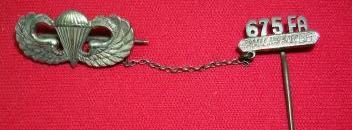 Wing with 675th Field Artillery Battalion pin |
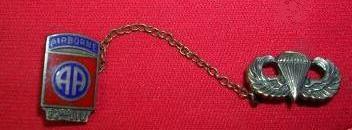 Wing with 82nd Airborne Division miniature DI |
Repros
I talk a lot about repros on this site, but for this article I am going a bit more in depth because for this item there are more repros than originals. I figure that if you buy a repro as a ‘filler’ for your collection, at least it should be perfectly made, and reasonably priced. If you can’t be sure it’s original, assume it’s a very good repro, and don’t pay too much. The more stars, the rarer, so a whole cottage industry has arisen to supply us with what we want. As repros go, some are honest (which doesn’t necessarily mean they are well made), others are real forgers who combine genuine wings with genuine stars, and invent a bullshit story for eBay, and others again will flog you any old scrap you are willing to believe are ‘experimental pathfinder wings’. The same applies to wings with other devices, such as a chaplain’s cross. Originals are very rare, so beware. Nice repro wings can often be found sold as ‘recasts’. This means an imprint of an original wing was made to cast a new one. Often these recasts use silver filling to obtain the same authentic patina. By using a ‘used’ wing to make the cast, the recasts also get a nice worn and aged look. Generally, such wings look great from the front. At the rear they are smooth, but not really flat, and never hollow. However, the rear may be marked with the name of a manufacturer, which is of course fake.
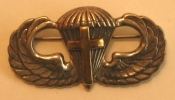 |
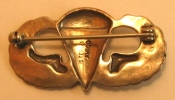 |
This is a nice repro Chaplain’s wing I bought from Garcia Aviation. On display, the front looks just as authentic as my original badges, but the reverse side gives it away as a repro.
Unidentified
These pictures were sent to me in May (2008). This badge appears to be Australian or British-made by the wing pattern and pin/hook clasp. However the parachute has been removed and replaced by a “rampant lion” of some type. I have no idea if this is insignia or jewelry, but it’s sterling, well made, and old. Does anyone recognize the lion-devise? It looks like a Dutch or Belgium cap badge, but I can’t find any reference of it.
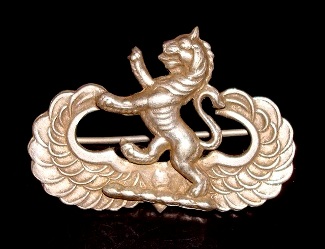 |
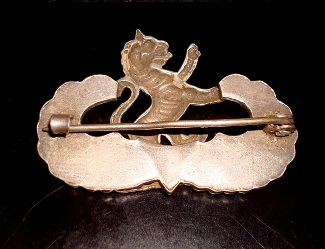 |
Bronze JR Gaunt jump wings
Paul Matlock sent me these pictures of jumpwings made by JR Gaunt. Identical to the ones pictured above, but in bronze instead of silver plated. It doesn’t look like the plating has been worn or polished off. It looks authentic to me, but the first time I see one like that. If anyone has one like this or knows more about it, please comment.
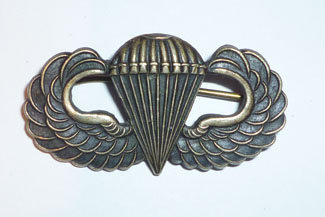 |
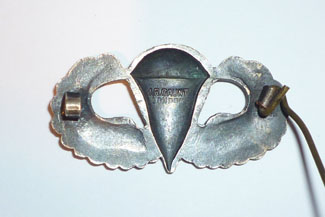 |
Plastic clutch back jump wings
This set of jump wings is for sale at paratrooper.fr. At first sight, they look like normal silver plated clutch back jump wings, but they are in fact made of plastic and painted. These are said to be a rare British Made late war economy model, although they are unmarked. They come from a veteran of the 501st PIR, 101st Airborne. It’s the first time I see one like this, so they must be rare, but they are priced accordingly. Photos courtesy and copyright of paratrooper.fr.
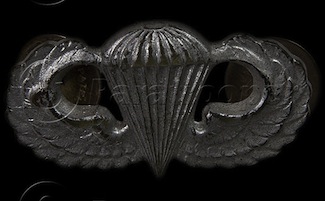 |
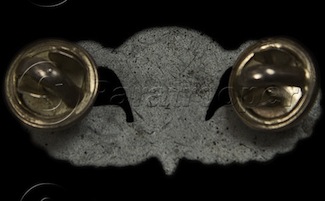 |
Jump wings with loops
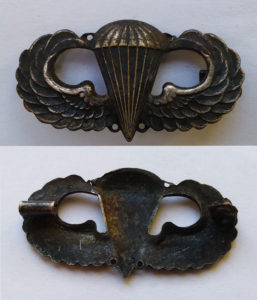
Jump wing with loops
Kamil, a collector from Poland bought these very peculiar jump wings off a roof repair company who found it at an attic in France.
The holes are at the top and bottom seem to have been intended for sewing the wings onto fabric. I haven’t seen this before. The holes (or loops rather) don’t look like they have been welded on, but seem to be integral part of the wings. The latter would mean that these wings were cast with the loops, which would surprise me because then, why would they have kept the attachments of the clasp at the back if it was intended for sewing on?
It looks like the badge is made of silver. It’s quite dark in the photos so it could well be.
If anyone has ever seen similar jumpwings or has more information or ideas about this, please comment.
Screw-back jump wings
Chris Brown sent me these photos of jump wings with a screw-back. Something I had never come across. He tells me these were worn on helmet liners by troopers on guard duty, parades, and ceremonial events. They are full size, but with one threaded post. As you can see, these aren’t modified; they were produced this way for this soecific purpose. He says he acquired several like this from an estate in Vermont. They were accompanied by a sterling “GP” marked wing. They are very scarce and it was also the first time Chris had seen any in his 50 years of collecting.
SAARF wing
This new addition to the jump wings page is very special in that it was issued to maybe only 100 Americans for a unit that existed for only a few months. The Special Allied Airborne Reconnaissance Force was formed in March 1945 and disbanded in July. I had never heard of it before until I did some research when I saw this lot offered on eBay (see pictures below). It included an original SAARF wing, a reproduction SAARF title and an original SHAEF patch. The wing looks good to me, but I don’t have any good reference pictures.
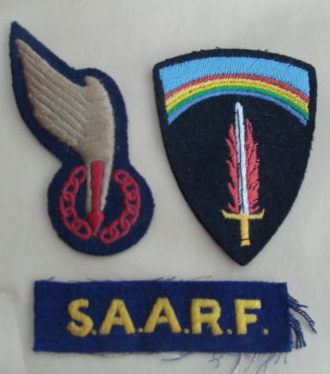 |
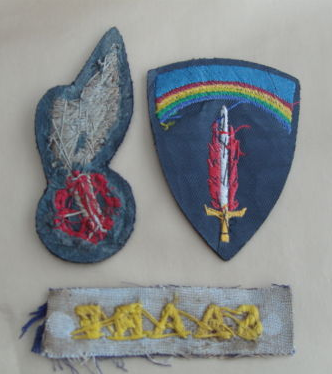 |
More information about the history of the SAARF and its insignia can be found here on insignia.org.
Post-war jump wings
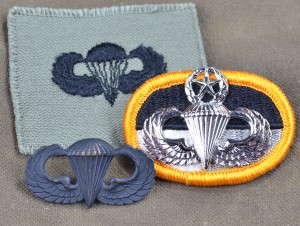 When did the Army stop issuing the Sterling jump wings, and when did they stop issuing the silver plated wings?
When did the Army stop issuing the Sterling jump wings, and when did they stop issuing the silver plated wings?
Steve Curlee raised this very interesting question to me, and he came up with the answer too. I had been wondering about this myself, so I thought I’d share this information here.
From the Institute of Heraldry, he got this reply: “We have the Military Specification Sheet which is dated 25 September 1964 for the US Army Parachutist Badge. The material was Sterling Silver.”
“The military specification sheet dated 11 July 1968: the material was changed to 1/20 Silver filled (Front Only) over a commercial copper base alloy for the non-subdued badges, and Red Brass was used for the subdued badges.” Steve himself was issued this type of Parachutist Badge in 1970 (see photo).
“The military specification sheet dated 10 February 1988: the material was changed to Red Brass or Nickel Silver. The brass was finished with a nickel plate, then silver plated with an oxidized, relieved matte finish. There was an option for commercial sale only using Sterling Silver.”
This means no Sterling silver wings were issued after 11 July 1968. Although there was some silver after the change on 10 February 1988, to say that they were silver plated is a stretch, but this does make it confusing to properly date jump wings marked ‘Sterling’.
“If we would know when the Army changed from the pin back (jewelers clasp) to the clutch back jump wings, we’ll know when the U.S. Army stopped issuing the original WWII era design and silver composition jump wings. So if anyone can enlighten us here, we’d be much obliged.”
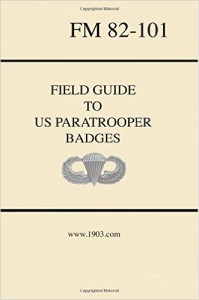 This question has ended my article about jump wings for a long time. Recently I was contacted by Joe Weingarten who was able to shed some light on this.
This question has ended my article about jump wings for a long time. Recently I was contacted by Joe Weingarten who was able to shed some light on this.
The US Army changed to clutch back in late 1944 for all wings, badges etc. However many manufacturers continued to make pin back until the start of the Vietnam era. The pin back badges were sold in Base and Post Exchanges as these are considered private sales and not government contract.
The Army has never stopped issuing the WWII design which is still in use today. But by 1950 they were issuing only clutch backs. During the Vietman era they moved to the plated badges and by 1974 silver filled were no longer issued.
Joe is the author of the book “Field Guide to US Paratrooper Badges“, which you can buy at Amazon. Joe also has a web site selling very nice reproduction sterling jump wings. His BB&B reproduction has already been discussed on this site, but he has them with almost all the different hallmarks you can think of.
Related links
Special Force wing
Post-war jump wings
Gen. Yarborough’s Patent application
Static Line magazine
Interview with Gen. Yarborough by Andrew Reed
You can contribute too:
This article describes the jump wings that I own or have pictures of. You are welcome to contribute with any additional pictures and information you may have. I am particularly interested in completing the list of manufacturers.

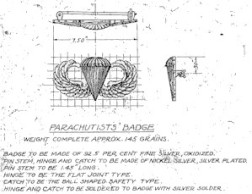
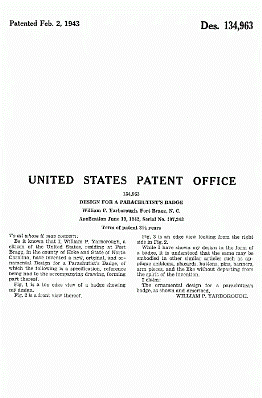

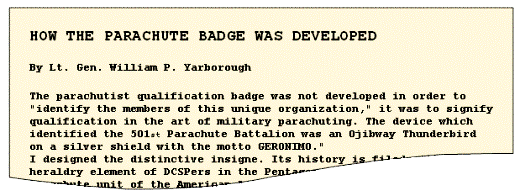
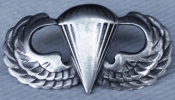



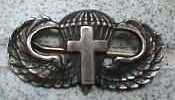
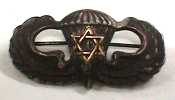

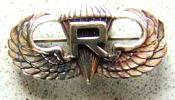
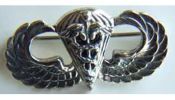
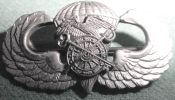
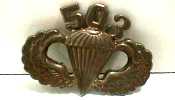
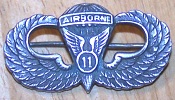
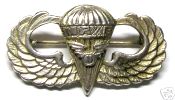
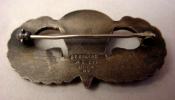
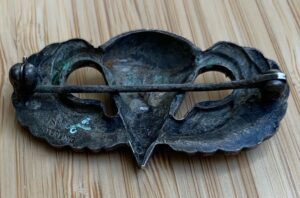
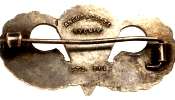
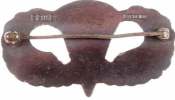
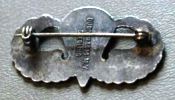
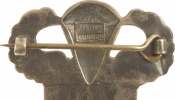
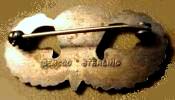

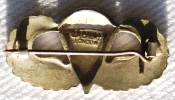
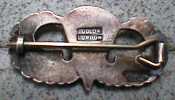
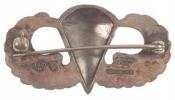
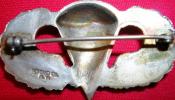
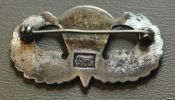

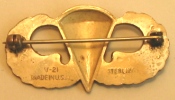
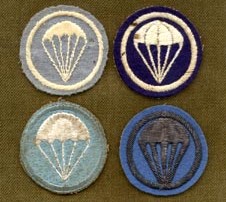

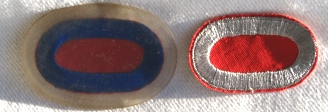
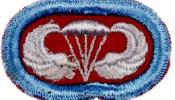
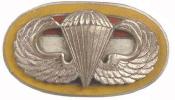
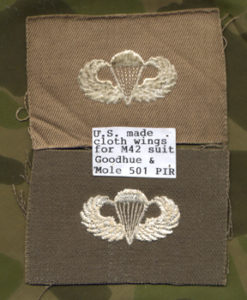
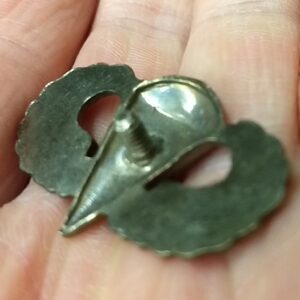
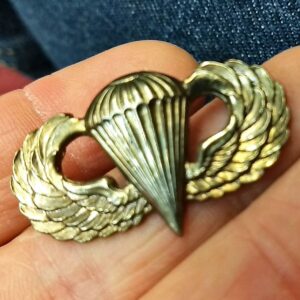

I have come across a wing with 11th airborne DI. sterling silver. I have seen others as the one posted above. This is the first 11th Airborne I have seen. I believe this to be WW2 era. Can you give me any information on this item?
I graduated from jump school in march of 1991. At the time there was a store called Ranger Joe’s. That sold a set of jump wings called the Yarborough jump wings. They were highly detailed. From what I can remember even the feathers were highly detailed. During one of our formations, our 1stSgt told us we could not wear this set of jump wings. They were not authorized by the army, So I never bought a set. They cost about 14.95 at the time. Does anyone have any info on this set of wings?
thanks Chad
I have a set, from what you are describing they sound like the correct wings. Hit me up I will send you a picture. chadparkening@hotmail.com
The rampant lion resembles the family crest of Sir Henry Russel, 2nd Baronet and the person who raised a regiment of the Indian Army presently known as Kumaon Regiment. The cap badge of the regiment is also the rampant lion similar to the one on the wing. I do hope that sheds light on the query.
Indeed, I see some important similarities. However, the lion on this jumpwing doesn’t hold a cross as in the crest Kumaon Regiment. Still, it’s an interesting lead. Hopefully more people will come forward with information or similar badges.
The background oval next to the 501st is that of the 503rd Parachute Regiment. In WW II, various battalions made combat jumps on Noemfoor Island and Corregidor. The 1st and 2nd battalions composed the infantry force of the 173rd Airborne when it deployed to RVN in 1965. I went over as attached to 4/503rd in 1966 (it had been 1/501). The third battalion was formed at Fort Bragg and deployed to 173rd in late 1967. The first and second battalions are now the infantry element of the 173rd Airborne Brigade. These have had numerous deployments to Iraq and Afghanistan.
I was looking around the internet for a picture of silver wings with a bronze star in the middle to flesh out some military information on my late father-in-law, James Wilfred Thornhill of the 101st Airborne, who fought in the Battle of the Bulge. In a letter he wrote home, dated 12 Jun 1945 he stated that he would be receiving a “little pair of silver wings with a bronze star in the middle for the combat drop in Holland.” The wings entitled him to $30 extra dollars a month. Sadly, the wings are no where to be found, but I thought you might like to know how much they were worth as far as pay for the soldiers. Thank you for the picture of just what I was looking for! Karen M. Thornhill (Army Brat all the way.)
I have a pair of sterling wings and I was just wondering if you can help me find some spurt of date accossiated with the wings it would be awesome. I do ww2 reenactments and I don’t want to put a pair of ww2 jump wings on my dress uniform so please help if you can. Thank you
Hi, are you asking me to date your sterling jump wings, or where you can buy good replica wings? I’m not sure I understand.
yes i was asking you to date them if possible please.
Hi, you can send pictures of your jump wings to paratrooper.be@gmail.com and I’ll have a look at it for you. Kind regards, Wouter
My grandfather jumped on D day he was in the 507 his wings have 3 silver stars but no arrow head. Why would there be no arrow head?
Hi, that’s an interesting question. I wondered about that too when I noticed that not all jump wings of paratroopers who jumped at D-Day had arrowheads. Some don’t even had a star! I never bothered to look it up, but here on the Triggertime forum, you can read that the stars were optional, and that the arrowhead wasn’t even authorized…
Here’s the link: http://triggertimeforum.yuku.com/topic/6085#.UlFUMWTk_gI
Hi Wouter Has, I was Out Metal detecting tonight and found my First set of Wings. They were burried about 5 inches in the Dirt. This was very exciting because I have seen other guys find them detecting and always had them on my “Want” List to find. Since I didnt see the one that I found on your list I figured I would write and see if maybe you might know about it. It is completely smooth on the front and is marked “Silver” on the reverse with no makers mark and is a Pinback with the rusty pin still attached. If you have any info or would like a pic as soon as I dug It and cleaned up I would be Happy to send the pic so you can post it on your site. Hope to Hear from You, steve
Hi Steve, that’s interesting. Sure, send over a photo and I’ll add it. Curious to find these in the ground as they weren’t worn in combat much. Grtz, Wouter
Jump wings were often worn on jump jackets when soldiers would jump in combat.
Paratroopers often buffed the front of the parachute to be smooth. My Dad was in the 505th from 1948~1953, then to 77th Special Forces; then OCS. He said that as a young trooper they would buff them with Brasso on a piece of cardboard. After I got my wings in 1980 I did the same thing — the Brasso/cardboard worked.
—
Just found your site today and have enjoyed every bit of the two hours I have spent here! I will be back on a regular basis.
I am the grandson of a paratrooper of the 505 PIR. He jumped in Sicily, Italy, Normandy and Holland. He was also at the Bulge. I am attempting to put all of his decorations together in a shadow box so my children and my nephews and nieces can appreciate what their Great Grandfather did for them. Unfortunately, I am missing his jump wings. Where can I get a set of jump wings with four jump stars and the arrow head? I appreciate any assistance?
John in AK
Hello John, on eBay you can regularly find good reproductions (assuming a nice reproduction is what you are after). I don’t know of any online dealers where you can buy them off the shelf. Alternatively, you could buy a pair without wings and arrowheads and source them separately and add them to the wings yourself. That will cost you less. I hope this helps. Regards, Wouter
Hi, i see I am more than 6 years late responding to this question about jump wings with jump stars. So, for what it’s worth…i was just browsing on the Internet looking for jump wings and came across the 82nd Airborne Division Museum shop, where they sell jup wings with stars. This is a link to one of the pages of the shop: https://www.82ndairbornedivisionmuseum.com/product-category/wings/page/2/
I bought a box of old vintage items to sell on line. It keeps me in cat food.. In the bottom there was a WWII paratrooper clutch back. It came in a baggy from an unknown jeweler with a paper saying it is sterling and sterling filled 1/20, 7.8 gr.. There is no sterling stamp on back. It has “Meyer, Inc., NY. It has 20 SIL. FLD. stamped. It has one small shield that is stamped 22/M. It has another small shield where the printing is too tiny for me to read. I would love to know how much it is worth. The patina is very old. May I send photos to your website? Address? I just had bypass surgery and could use the funds.
Hello Sandy, sure you can send me pictures at paratrooper.be@gmail.com, and I’ll have a look at it for you.
Regards, Wouter
Looking for black jump wings worn on fatigues in Vietnam 1969.
Hi George, you mean black metal jump wings, right? I have a pair that I would sell if you’re interested. I’ll send you an e-mail with a photo.
Regards,
Wouter
Hi Wouter. I’am a high school student with a great interest in ww2 history. I hope to one day teach ww2 history and would love to start a collection that I could show my class to help bring the history to life. I’am looking for a pair of World War 2 jump wings with a combat star on them to start my collection. I would pay $100 for them. Thank you!
Regards,
Scott
Hello Scott, Sounds like you’d be a cool teacher! Jump wings with a combat star (original) would cost you more than $100. I don’t have any myself. Still searching for a pair I can afford and that are trustworthy. Kind regards, Wouter
Go on eBay they have plenty of different wings
I bought 2 sets of wings off of eBay they stated that they were from WW2. One has the pin back type it has only sterling imprint on the back of the parachute. Don’t know who made that one, also the other has a hook type pin never seen one like that , it also has the sterling imprint and the back is flush . Can you tell me were their from.
Hi William, if you can e-mail me photos of the front and back, I can have a look at them for you: paratrooper.be@gmail.com
Kind regards, Wouter
Very cool info! I graduated Airborne School in early 1996. When my grandfather passed away I got his jump wings from the early 1950’s (pin-on American version). And my jump wings rest with him.
I’m looking for my dad’s jump wings from world war II and can’t find them
i have 2 english ww 2 jump ovals black in center red pinline who were these made for
ty
martymcdaniel@charter.net
Hello Marty, can you e-mail me a photo? I don’t know of a WW2 black oval with red trim, but there are color variations of the oval of the 507th PIR. Theirs was black with an orange border.
I have a set of wings which are paired with a metal oval. the oval is blue with a metal border. The inlay appears to be blue enamel. Here is a link which has a set very similar, but no information on them. Do you know anything about them? http://quanonline.com/military/military_reference/american/wwii_medals/wings.php
Hello Michael, these are post-WW2. Don’t know what regiment they were for, but like it says on the site you refer to, they are from Korea-era or even later.
Hi,
Interesting site, but you have an informational error in your text. You state that clutch-back wings were introduced late in the war. This is untrue. The clutch-back attachment was introduced in the late 1930s. I myself have seen a 1942 MS Myers catalog that shows the parachutist’s badge offered in both pin or clutch-back, and the clutch-back version was .05 cents more expensive!
Regards,
Mark ~
Hi Mark, thanks for this information. That’s news to me indeed. Could you send me a scan or a photo of that catalog? It would be great to add it to the article.
Great article and info. regarding jump wings. I do have a small pin which I think could be rare. It is made in Japan and it has a screw on latch. If author wants to see the photos of it, please contact me as you have mentioned above that you haven’t came across one of them.
For the most comprehensive book on the Paratrooper badges I would like to suggest you view “Field Guide to US Paratrooper Badges.” Now in its fourth edition the book keeps growing with more and more badges and information. Available from our web site or Amazon.
Thanks for your suggestion Joe!
I am trying to find out what oval would have been worn for the 17th airborne division, 193rd glider infantry regiment. Any help would be appreciated with pictures or information. Thanks
Hello Noah, I can’t answer that conclusively as I don’t have a book stating the colors for this regiment. In “America’s Finest II” there’s a whole overview of ovals and there are a few color combinations that were worn by various units that did not have their own backgrounds:
Dark blue with white border (although also used by 509th PIR and 325th GIR)
Red with red border for parachute and glider artillery
White with white border and dark blue with blue border, both for parachute and glider infantry.
I hope this helps!
CSM Horace Pearl had 6 stars, 3 on each wing. Four jumps in WWII and two in Korea.
What is the paratrooper wings with a pine tree?
Hi Rebecca, that’s not a pine tree, but an arrowhead. It’s for participating in an amphibious assault (Sicily or Normandy), even though paratroopers parachuted in. So for the Holland or Varsity jumps, for example, one would have obtained a star and no arrowhead. The device is actually meant to be attached to medal ribbons, not jump wings. Here you can see which ribbons this has been authorized for since WW2: https://en.wikipedia.org/wiki/Arrowhead_device
Hello – thought may you could lend some advice. I saw jump wings on ebay. The description states: This is a vintage WWII Navy & Marine Corps Parachutist Badge (originally known as the U.S. Navy Certified Parachute Rigger badge, 1942-1963). Badge is 1 3/8” long and hallmarked with the MEYER Shield, 1/20 10K Sterling. The pin, hinge and hasp are in excellent condition. The ebay item number is 182202790244 to view the photos. Anyone have an idea of its value? IS this a rare item, because I cannot find much info on it and there doesn’t seem to be any others selling on ebay? Thanks
Hello Don, I don’t know how rare these post-WW2 wings are, but this seems quite expensive to me.
Thanks for the feed back – you mention post-WW2. How do you determine post-ww2 vs. ww2?
I have the south African wing which is mine what is it worth
Hello Renaldo, Foreign wings aren’t my specialty, but can you send photos?
I have a set of Airborne wings with an eyeball in the middle of it. I got it from a retired Master Sergeant .I was wondering if anyone could tell me what it goes to,what unit?.he was in the artillery.
My grandpa had a large pair of jump wings they were to big to be pins I don’t know if they have a different name but from what I can remember they were maybe 8-10 inches long in 4-6 inches high and I have never seen anything like them
I have a set of wings that i found in a thrift store… would you be able to help me identify the era? I have searched many internet pages and have come up with very little on the markings on these badges. I appears to me that you have quite a bit of knowledge and i would be thrilled if you could help me out.
Sure, just send me a photo at paratrooper.be@gmail.com and I’ll have a look at it for you.
found what looks to be brass jump wings but are larger 1 1/2×3/4.cought my eye wanted to know more. Was with 82 and 173rd.My brother thought they were marine wings.
Yes Frank, from the description it sounds like marine wings. But if you can send me a sharp photo of the front and back, I can have a look at it for you.
Kind regards,
Wouter
The SAARF badge and title are both reproductions. Enjoyed visiting your site
Hi Mort, thanks for sharing this. What make them stand out as replicas to you?
hi Wouter,
I just saw someone in Holland selling a jumpwing with a skull on it? Is that a real one or is it a fake jump wing. Did you ever heard about it?
he is asking a lot of money for it.
Hi Dennis, I don’t know about that. I have seen post-war wings with skulls and/or bones. Do you have pictures of front and back?
Wondering u can take a look at my dads jump wings witch where given to him by his dad when he graduated jump school.
My grandfather was in the 101st abn in the 60s. Soon those wings will be mine.
3rd gen!
Getting back on track . I cant figuer how to post the pics.
Sure, send my photos and I will have a look
I have come across a hot air balloon pin with wings, with a bronze brown patina, and green aging on the clutch back pin fasteners. The back side of the pin has these markings: “G23” on the left wing, and “1/20-S.F.” The back of the balloon is hollow, not flat. Can you tell me what they mean? Thanks!
Hello Janice, I’m not familiar with that, but going by your description, I would say it’s post-war (due to the code G23). 1/20 S.F. means that it’s not pure silver or sterling silver, but 1/20th Silver Filled. That’s a pretty new alloy. You can find out all about it on this page, for example: https://www.artfire.com/ext/shop/blog_post/popnicute/4331/what_are_the_difference_between_gold_filled_gold_plated_sterling_silver_and_silver_plated_
Could you send me a comment back knowing that you’re still around. I have quite a few jump wings and sometimes have questions about their legitimacy. Thank you very much Eric
Still around 😉 I sent you an email.
Dear, i think the lion on the unidentified one iw from a belgian soldier for the britisch army . Brigde piron
Hello Martijn, that’s interesting. It could well be because I still haven’t found any other evidence. But do you have any information to link this to the Brigade Piron?
A main brand of jump wings not listed in your great article is KREW. On the back of the wings the left of the parachute is says KREW GI. To the right it says 1/20 Sil. Filled. This is the brand still on my Class A uniform and that was for sale at the Airborne PX on Ardennes Street at Fort Bragg in the early 1970s. I have several of those. Another brand I ran across on eBay reads (if I read it right from the eBay photo) HLP-GI (left side), 1/20 SF (right side). Thanks!
Hi Ron, thank you for bringing this to my attention. I’m sure these are post-war wings though, because the 1/20 silver filled type is post 1968 (see details about it in the article). I have no knowledge of wartime wings made by Krew.
I need to find where I can purchase Sterling Silver Jump Wings. Any ideas?
Hello Jim, they can usually be found quite frequently on eBay
Any more info about the bronze plated jump wings? I’ve recently bought some jump wings with the words SIMCO-G1 on the back of it. The finish looks very similar but mine are clutchback instead.
Hi Mike, no comments on the bronze plated wings yet. The marking on yours, as wel as the fact they are clutchback, make them post-war though.
How do you determine if a particular jump wing is WWII era? Do you go by markings on the back? What if there are no markings except the word “Sterling”?
Hello Jim, I wish I could give a straightforward answer, but as you have probably figured from my article, it isn’t always easy to be sure. It’s more a question of elimination. Certain characteristics certainly make them post-war of reproduction. But after ruling out what I know, it’s still not always certain, and the quality of reproductions can (and will) improve. If they are marked Sterling, this doesn’t necessarily mean they are war-time, but they can be. The safest bet is to look for one with a manufacturer hallmark, although copies of those exist too. These are generally more expensive than jump wings that are only marked with Sterling. I hope this helps.
Hi Wouter
Thanks for response. One of my father’s really worn jump wings back says sterling and the backside of the parachute is recessed instead of flat. Been trying to find a match. Pins are broke off. He was with 101 during WWII. Appreciate your input
Jim
Hello
Have you informations aboit this marking on back of air wing please ?
1/20 SIL.FILLED S 21
Cordialement de France
Christophe
Hello Christophe, jump wings marked on the reverse with a single letter together with numbers are post-war made wings. Silver Filled is a new specification from the late 1960s. You can find this in my article.
Bonjour,
J’ai un brevet de parachutiste qui je pense est en argent, avec 2 pins derrière. En bas à droite il y a un marquage S21 G.I. Est-ce de la seconde guerre mondiale ?
Merci pour votre réponse.
Bien à vous.
Martine
Hello Martine, quand c’est marqué S21 G.I. c’est après guerre. Voir schema dans mon article: jump wings marked on the reverse with a single letter together with numbers are post-war made wings. Kind regards, Wouter
Great info!!
You mentioned you had additional info that you were going to post on the Glider badge… do you have a link to that info?
I am interested in the very first made Glider badges for the 101st for the Normandy insertion (Glider riders not glider pilots).. I understand they are a bit different looking and there may have been two issues of these.
Thanks!
Hello Linda, yes I meant to write an article on the glider wings as well, but never got around to it. I have several myself, but the design of each is the same. The differ in size and one has a combat star.
Do you have a photo of the airborne trooper’s wings with 6 stars? I have it if you care to post them.
Hello Glenn, yes I remember you sent this to me back in 2018. This is the post I did at the time: https://www.paratrooper.be/2018/10/jump-wings-with-6-combat-stars/ Maybe you have more information that I can add? Best regards, Wouter
Does anyone know which maker (post war) was 022 clutch back wings? Please semd answers to [pastorchrismyers@gmail.com or email below
thanls for your help in advance
Hello Chris, that would have been O22 (not 022), which stands for Officer’s Equipment Company, Stafford, VA. I found it here: https://www.usmilitariaforum.com/forums/index.php?/topic/224854-list-of-manufacturers-of-us-metal-emblems/
Kind regards, Wouter
Hi Wouter,
Thank you so much for collecting all this info! I sent you and email with pictures of some allegedly WWII sterling clutchback wings made by N. S. Meyer that have a star on top of the parachute without the wreath. I am hoping you can tell me the meaning of the star and whether or not they are in fact WWII wings.
Hello Courtney, I sent you a reply by email. Regards, Wouter
Wouter,
Thanks so much for the great background. I spent a some time with the 82nd ABN DIV and earned my Master Parachutist Badge while serving there. I recently bought a phenomenal art piece that features 13 signatures from veterans of the D-Day jump and was hoping to find some original jump wings to add to the art and photos I have for framing. Would you be able to point me in the right direction. Please email me directly.
V/R
Travis
Wouter,
Outstanding background information. I have some follow-on questions if you have some time.
V/R
Travis
Hello.
I read his description on the badge.
I am looking for an original and I came across a pins that may be a fake, but I wanted to show you a photo to get your opinion.
Sure,if you can email me clear photos of the front and the back, and especially the markings.
It’s very interesting to know about the jump wings badge and it could vary a lot since it has been collected and decorated personally with a rabbi’s star of David or the rigger ‘R’. I’m looking into how different these insignias could be as I am actually planning to find somewhere to purchase one. I hope I could find one for the military.
Hallo,
Wonderfull and complete info .
I have 2 wings one is a bronze one, i read you do not know that they exist? An other is marked with GI UT can you help me with that? Where it is made and how old?
Kind regards
Jochem Blok
Hi Jochem, that sounds nice. If you send me photos of the front and back, I will have a look at it. If they are marked GI + some code, they are post war. Kind regards, Wouter
Very good information you got back from the Institute of Heraldry on the switch to 1/20 SF from sterling. I would like to know if you have ever heard an exact date G.I. was added. It seems to differ but we know from medals in dated boxes it was in the mid 1960s. The issues that arise are the three digit codes for makers like Harry Sugerman S21 and the V21s, D22s etc that everyone puts in the 1964 to 1974 or newer catagory that also lack the G.I stamp. It makes things difficult to determine if insignia would have been used in Vietnam and not post war. I have come to assume a S21 marked wing or even rank insignia without the G.I. mark must have been made in the few years between the 3 digit assignment in 63/64 and the institution of the G.I. mark. But my theory could also be entirely wrong. Either way I see a large number of people simply avoiding collecting the 3 digit codes if we don’t have a firm date on when a company went out of business like Bell Trading did in 1969 where you see GI and sterling together on jump wings just like your letter from the Institute confirms. I have boxes of insignia from years of collecting that I want to display as Vietnam era but hesitate to.
Thanks for sharing your views on this Brandon. Your theory makes sense. I can’t add anything to it one way or the other, as I don’t know more about it myself.